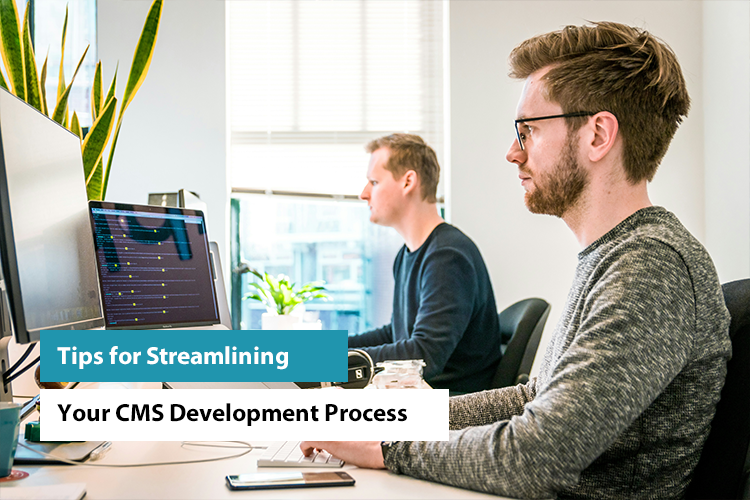Tips for Streamlining Your CMS Development Process

Have you ever wondered what it takes to create a seamless and efficient Content Management System (CMS)? The process of CMS development can be a labyrinth of complexities and challenges, but with the right strategies, you can transform it into a well-oiled machine that saves you time, minimizes errors, and yields superior results. In this exploration, we embark on a journey to uncover valuable insights and expert tips for streamlining your CMS development process.
Your CMS is the gateway to building and managing your website with finesse. From defining your objectives and selecting the right CMS to designing a user-friendly interface and embracing modular development, we’ll navigate the landscape of CMS development step by step. By the time we’re done, you’ll be armed with a comprehensive arsenal of strategies to take your CMS development process to new heights. Let’s get started!
1. Define Clear Objectives
Defining clear objectives is the critical first step in streamlining your CMS development process. It provides direction, purpose, and a framework for your project, ensuring focus and efficiency. Here’s why it matters and how to do it:
Clear objectives bring focus and clarity to your project. They minimize confusion, miscommunication, and scope creep. By setting boundaries, objectives prevent uncontrolled feature additions that can cause project delays and increased costs. Objectives also help with resource allocation, enabling you to prioritize tasks and manage time, budget, and personnel efficiently. Additionally, they align stakeholders and team members by ensuring everyone understands the project’s goals.
To define clear objectives:
- 1. Understand your organization’s business goals and how the CMS project fits in.
- 2. Use SMART criteria (Specific, Measurable, Achievable, Relevant, Time-bound) to frame your objectives.
- 3. Consider audience and user needs and conduct competitor analysis.
- 4. Distinguish between short-term and long-term objectives.
- 5. Keep communication open with stakeholders to adapt objectives as needed.
For instance, in an e-commerce CMS project, short-term objectives might include implementing a user-friendly CMS in three months, while a long-term objective could be becoming a niche market leader within two years. Clear objectives serve as the blueprint for your CMS development process, leading to more efficient and successful outcomes.
2. Choose the Right CMS
Selecting the appropriate Content Management System (CMS) is a pivotal decision that significantly impacts the efficiency and success of your development process. The right CMS choice can streamline your project in several ways:
- 6. Scalability: Consider the scalability of the CMS. Will it support your project’s growth and evolving needs? The right CMS should provide room for expansion without requiring a complete overhaul.
- 7. Ease of Use: A user-friendly CMS simplifies content creation and management. It reduces the learning curve for your team and clients, making day-to-day tasks more efficient.
- 8. Security: Prioritize security. Choose a CMS with a strong track record of security and robust measures to protect your website and data. This reduces the need for additional security efforts and fixes down the road.
- 9. Customization: Evaluate the customization options. The ability to tailor your CMS to specific project requirements is crucial for creating a streamlined and efficient development process.
To choose the right CMS:
- 10. Research: Explore various CMS options and their features. Consider popular choices like WordPress, Joomla, Drupal, or even custom solutions tailored to your exact needs.
- 11. Assess Your Needs: Match the CMS features with your project requirements. Different projects may require different CMS solutions. For instance, WordPress is excellent for blogs and small to medium-sized websites, while Drupal offers robust customization for complex, enterprise-level projects.
- 12. Community and Support: Examine the CMS’s community and support. A strong community means access to valuable resources and assistance when issues arise.
- 13. Testing: Before making a final decision, test the CMS to ensure it meets your specific needs and expectations.
The right CMS choice is fundamental to streamlining your development process by providing a solid foundation that aligns with your project’s objectives and requirements.
3. Plan Your Content Strategy
A well-defined content strategy is the backbone of a streamlined CMS development process. It shapes how you create, organize, and present content, ensuring your CMS aligns with your project’s goals and user expectations. Here’s why it’s crucial and how to go about it:
A content strategy is vital for efficiency. It offers focus and direction, reducing the risk of disorganized content and wasteful, time-consuming revisions. It’s also essential for maintaining consistency in branding, voice, and messaging throughout your website.
To plan your content strategy:
- 14. Audience Analysis: Understand your target audience and their content preferences. Tailor your strategy to meet their needs and expectations.
- 15. Content Structure: Develop a structured content plan, defining categories, tags, and metadata. This enables you to organize content logically and improve user navigation.
- 16. Content Calendar: Create a content calendar to schedule updates, ensuring regular and relevant content publication.
- 17. Content Types: Decide on the types of content you’ll use, such as articles, images, videos, and more, and how these fit into your overall strategy.
- 18. Keyword Research: Incorporate SEO by conducting keyword research to optimize content for search engines.
A well-planned content strategy streamlines CMS development by providing a roadmap for content creation, minimizing guesswork, and ensuring that your CMS efficiently supports your project’s content requirements.

4. Design a User-Friendly Interface
Creating a user-friendly interface is not just about aesthetics; it’s about optimizing the user experience and enhancing the efficiency of your CMS development process. A well-designed interface simplifies content creation, editing, and management, reducing the learning curve for your team and making it more attractive to clients or end-users who manage their content. Here’s why designing a user-friendly interface is essential and how it benefits your CMS development:
- 19. Efficient Workflow: A user-friendly interface streamlines the workflow by offering intuitive navigation, straightforward labeling, and a clean design. These elements reduce cognitive load and make tasks more manageable and less prone to errors.
- 20. Reduced Training Needs: When your CMS has an intuitive design, your team can become proficient more quickly. This minimizes the time and resources spent on training, allowing your team to focus on productive tasks.
- 21. Client Satisfaction: A user-friendly CMS is appealing to clients and end-users who manage content. A smooth and intuitive interface enhances their experience and satisfaction, which can contribute to the project’s success and reduce support requests.
To design a user-friendly interface:
- Understand the user’s needs and expectations.
- Conduct usability testing to gather feedback and refine the interface.
- Prioritize simplicity, consistency, and user-centered design principles.
By designing a user-friendly interface, you create a CMS that fosters efficient content management, reduces user frustration, and makes the development process more effective and user-oriented.
Also Read Our Blog: Cracking the Code: How to Pick the Right CMS for Your Website
5. Embrace Modular Development
Embracing modular development is a strategic approach that can significantly enhance the efficiency of your CMS development process. It involves breaking down your CMS into smaller, self-contained components or modules that can be developed, tested, and deployed independently. Here’s why modular development is crucial and how it benefits your CMS development:
- 22. Focused Development: By dividing your CMS into manageable modules, you can concentrate on one piece of functionality at a time. This approach reduces complexity, streamlines development, and allows developers to work more efficiently.
- 23. Parallel Work: Modular development enables parallel work, where multiple teams or developers can simultaneously focus on different modules without interfering with one another. This accelerates project progression and minimizes bottlenecks.
- 24. Reusability: Well-designed modules are often reusable across projects, saving time and effort. This reusability can lead to quicker development and more consistent functionality in your CMS projects.
- 25. Simplified Maintenance: When issues arise, modular development simplifies the process of identifying and addressing problems within specific modules, making maintenance and debugging more efficient.
To embrace modular development:
- Analyze your CMS to identify logical components that can be separated into modules.
- Ensure that each module has a well-defined scope and functionality.
- Implement a version control system to manage changes to modules effectively.
By adopting modular development, you streamline your CMS development process, reduce complexity, and promote efficient development, ultimately saving time and resources while improving the maintainability and scalability of your projects.
6. Use Version Control
Version control systems are indispensable tools for streamlining CMS development. They help manage changes, track progress, and maintain code integrity throughout the development lifecycle. Here’s why using version control is crucial and how it enhances the efficiency of your CMS development:
Version control, exemplified by tools like Git, allows multiple developers to collaborate on the same project while keeping track of changes and versions. This ensures that code remains organized, and it prevents conflicts between team members.
With version control, you can:
- 26. Collaborate Seamlessly: Team members can work concurrently on various aspects of the project, merging their changes while minimizing the risk of code conflicts.
- 27. Roll Back Changes: In case of errors or unexpected issues, version control allows you to revert to previous, stable versions of the code quickly.
- 28. Track Progress: Monitor changes, and see who made them, and why. This audit trail is invaluable for debugging and project management.
- 29. Branching and Merging: Create branches for new features or bug fixes, and merge them into the main codebase when ready. This parallel development process accelerates project progression.
Version control streamlines your CMS development by ensuring a well-organized, collaborative, and transparent approach to code management. It reduces the likelihood of errors and conflicts, making your development process more efficient and reliable.
7. Automate Repetitive Tasks
In the world of CMS development, automating repetitive tasks is a powerful practice that can significantly enhance efficiency. By utilizing automation tools and workflows, you can save time, reduce errors, and maintain a consistent, streamlined development process.
Here’s why automating repetitive tasks is essential and how it benefits your CMS development:
- 30. Efficiency: Automation simplifies routine and time-consuming tasks, such as code minification, image optimization, and build processes. This frees up your team to focus on more creative and complex aspects of development.
- 31. Consistency: Automation ensures that repetitive tasks are performed consistently every time. It reduces human error, making your CMS development more reliable and less prone to issues.
- 32. Continuous Integration and Deployment (CI/CD): Implementing CI/CD pipelines allows for the automation of the entire development-to-deployment cycle. Changes can be automatically built, tested, and deployed, reducing manual work and the chance of human error.
- 33. Cost Savings: By automating repetitive tasks, you can optimize resource utilization and potentially reduce the need for additional personnel to perform mundane tasks manually.
- 34. Scalability: As your project grows, automation allows you to scale without a linear increase in effort. You can efficiently manage larger CMS systems and more extensive content repositories.
Common automation tools include Gulp, Grunt, Jenkins, and Travis CI. These tools can handle various tasks such as code compilation, testing, and deployment. By incorporating automation into your CMS development process, you reduce the time and effort spent on repetitive tasks, making your workflow more efficient and less prone to errors.

8. Prioritize Security
Prioritizing security is paramount in the CMS development process. A secure CMS not only safeguards your data but also streamlines development by minimizing the need for extensive remediation efforts. Here’s why making security a top priority is crucial and how it benefits your CMS development:
- 35. Risk Mitigation: Emphasizing security helps you identify vulnerabilities early in the development cycle. Addressing these issues proactively reduces the risk of costly and time-consuming security breaches or data leaks.
- 36. Stable Codebase: Security-focused development practices often result in a more stable codebase. By incorporating security measures into your CMS from the start, you reduce the likelihood of future disruptions caused by security-related issues.
- 37. User Trust: A secure CMS instills trust in your users, clients, and stakeholders. This trust can positively impact your reputation and user engagement, driving the success of your project.
- 38. Regulatory Compliance: Many industries have strict security regulations that CMS development must adhere to. Prioritizing security ensures you meet these requirements and avoid legal complications.
To prioritize security in your CMS development process:
- Implement security best practices, including authentication, access control, and data encryption.
- Regularly update the CMS and its components to address known vulnerabilities.
- Conduct security audits and testing, such as penetration testing and code reviews.
By making security a top concern, you reduce the likelihood of security-related issues, saving time, money, and potential reputational damage, and ensuring a more efficient and successful CMS development process.
9. Document Your Code
Documentation is a crucial but often underestimated aspect of CMS development. It’s the written guide that explains how your code works, and it plays a pivotal role in streamlining the development process. Here’s why code documentation is essential and how it benefits your CMS development:
- 39. Knowledge Transfer: Well-documented code is easier for developers to understand. When new team members join the project, they can quickly get up to speed, reducing onboarding time and potential errors.
- 40. Debugging and Maintenance: Code documentation aids in troubleshooting and maintenance. When issues arise, well-documented code allows developers to pinpoint problems more efficiently and make necessary fixes with confidence.
- 41. Collaboration: Documentation encourages effective collaboration among team members. It ensures that everyone is on the same page, promoting consistency in coding practices and better communication.
- 42. Future Enhancements: Documented code provides valuable insights for future enhancements or customizations. Developers can refer to existing documentation to understand how to make changes without inadvertently causing problems elsewhere.
To document your code effectively:
- Provide clear comments within your code, explaining complex or critical parts.
- Create separate documentation files or use specialized tools for generating code documentation.
- Keep documentation up-to-date, revising it when code changes are made.
By documenting your code comprehensively, you not only save time in debugging and maintenance but also ensure a more efficient and collaborative CMS development process.
10. Test Thoroughly
Thorough testing is an indispensable component of streamlining the CMS development process. It’s the systematic process of evaluating your CMS for defects, functionality, and user experience. Comprehensive testing ensures that your CMS functions as intended, reducing time and effort spent on troubleshooting and rework later in the project.
Here’s why thorough testing is essential and how it benefits your CMS development:
- 43. Bugs and Defect Identification: Testing uncovers bugs, errors, and defects early in the development cycle, allowing you to fix issues promptly. This minimizes the likelihood of critical errors going unnoticed and disrupting the project.
- 44. User Satisfaction: Thorough testing results in a better user experience. It ensures that your CMS works seamlessly, reducing user frustration, and potential bounce rates.
- 45. Quality Assurance: Rigorous testing enhances the quality and reliability of your CMS, ultimately contributing to a more successful and efficient project.
To conduct thorough testing:
- Implement unit testing to evaluate individual components of your CMS.
- Conduct integration testing to check the interactions between different parts of your CMS.
- Perform user acceptance testing to ensure that your CMS meets user expectations and requirements.
By thoroughly testing your CMS, you minimize the risk of errors and glitches, ultimately saving time and effort and promoting a smoother, more efficient development process.

11. Train Your Team
Properly training your team is a crucial aspect of streamlining the CMS development process. It ensures that your team members are equipped with the knowledge and skills needed to efficiently work on the project, reducing errors and misunderstandings. Here’s why training your team is vital and how it benefits your CMS development:
- 46. Efficiency: Well-trained team members are more efficient in their roles. They can navigate the CMS, understand its architecture, and work with its features effectively, reducing the time spent on tasks and minimizing errors.
- 47. Consistency: Training helps maintain consistency in coding practices, development processes, and the use of CMS features. This consistency ensures a smoother workflow and minimizes discrepancies that can lead to issues.
- 48. Onboarding: For new team members, effective training ensures a smoother onboarding process. They can quickly understand the project, its requirements, and the tools used, leading to faster integration and productivity.
- 49. Reduced Mistakes: Training helps prevent common errors and misunderstandings, which can save time by avoiding the need for corrections and rework.
To train your team effectively:
- Provide clear and structured training materials and documentation.
- Offer hands-on training sessions or access to training resources.
- Encourage open communication for team members to ask questions and seek assistance.
By investing in team training, you facilitate a more efficient CMS development process, minimize errors, and promote a shared understanding of project requirements and expectations among your team members.
12. Stay Updated
Remaining up-to-date with the latest developments, trends, and best practices in the field of CMS development is a fundamental aspect of streamlining your development process. Here’s why staying updated is crucial and how it benefits your CMS development:
- 50. Technology Advancements: The tech industry evolves rapidly, introducing new tools, languages, and frameworks. By staying updated, you can harness the power of the latest technology to enhance your CMS development.
- 51. Security: Cybersecurity threats continually evolve. Staying informed about the latest security vulnerabilities and best practices allows you to safeguard your CMS effectively and prevent potential breaches that can disrupt your development process.
- 52. Efficiency Gains: Staying updated can help you discover new tools and techniques that can improve the efficiency of your development process. Whether it’s streamlined workflows or improved collaboration tools, staying current can lead to time and resource savings.
- 53. Compliance: Many industries have specific compliance requirements that evolve over time. Staying updated ensures that your CMS development remains in compliance with the latest industry standards and regulations.
To stay updated:
- Regularly read industry news, blogs, and forums.
- Attend conferences, webinars, and workshops to learn about the latest trends.
- Collaborate with colleagues and engage in knowledge sharing within your network.
By staying updated, you ensure that your CMS development process remains efficient, secure, and aligned with current best practices and industry standards, ultimately contributing to the success of your projects.
Conclusion
Streamlining your CMS development process can save time, reduce errors, and ultimately lead to more successful projects. By defining clear objectives, choosing the right CMS, planning your content strategy, and implementing the tips discussed in this blog, you can streamline your development process and create high-quality websites with greater efficiency.
For further assistance in optimizing your CMS development or exploring innovative software solutions, consider reaching out to Imenso Software. Their expertise can help you unlock the full potential of your projects and streamline your development journey. Don’t miss the opportunity to take your CMS development to the next level.
We’re honored to mention that our efforts have been recognized by renowned B2B review and research platforms such as GoodFirms, Clutch, MirrorView, and many more.
Want more information about our services?
Similar Posts

How Much Does It Cost to Develop a Successful Trading and Investment App ?
Give a look at the top finance apps on the app store by App Annie. 30% of the total apps are trading and investment apps. ...

How to Build a Successful Vertical SaaS Application Business
Have you ever wondered why some software solutions seem to fit seamlessly into certain industries while others fall short? Picture this: a healthcare facility using software designed for retail, or a real estate agency struggling with a generic CRM system. It’s like trying to fit a square peg into a round hole. Yet, there’s a […]...

Ultimate Guide To Pick A Software Development Outsourcing Partner in 2023
The process of selecting a reliable outsourcing partner for software development is complex and time-consuming. You may need a few months to do your due diligence and narrow down your options to a single service provider with whom you feel comfortable making a long-term commitment....






